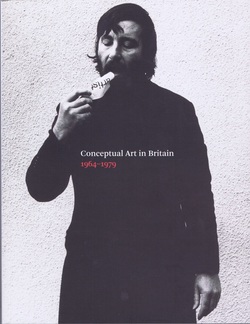
While traveling in Europe this summer I was able to see the Tate Britain exhibition “Conceptual Art in Britain 1964-1969,” curated by Andrew Wilson. His understanding of conceptual art is that it is an art that emphasizes process, “overturning definitions of artworks as material, measured by rigid volume and enclosed space, favouring instead measurements of time and duration of that which was open and fluid” (9). Many of the exhibits he offers are documentations, sometimes photographic, sometimes statistical, of artistic action. One of the first items in the exhibit is Richard Long’s Line Made by Walking (1967), a photograph of a field in which Long has walked back and forth until light reflecting from the trodden grass shows the effects of his intervention. His handwriting on the photo’s lower border of the title and “England 1967” adds another form of documentation.
There are a number of “walks” in the exhibition, including Hamish Fulton’s Hitchhiking Times from London to Andorra and from Andorra to London 9-15 April 1967, Long’s Dartmoor Walks (1972) documented with sketches and photos, and his Cern Abbas Walks (1975) which he documents with a map, photos, and a list of observations. These are remote forerunners of later “walk”-structured works, such as Lisa Robertson’s Occasional Work and Seven Walks from the Office for Soft
 RSS Feed
RSS Feed